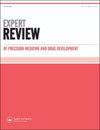Clinical application of personalized rheumatoid arthritis risk information: Translational epidemiology leading to precision medicine.
IF 1
Q4 PHARMACOLOGY & PHARMACY
Expert Review of Precision Medicine and Drug Development
Pub Date : 2021-01-01
Epub Date: 2020-12-14
DOI:10.1080/23808993.2021.1857237
引用次数: 2
Abstract
Over the last few decades, major progress has been made in identifying risk factors for the development of rheumatoid arthritis (RA), a relatively common chronic disease characterized by inflammatory arthritis with complex etiology [1]. These include both nonmodifiable factors, such as demographics and genetics [2], and potentially modifiable factors, such as cigarette smoking and elevated body mass index [3]. Clinicians may wonder how this growing knowledge may someday apply to clinical practice. A traditional view of epidemiology uses risk factors to passively elucidate an overall disease process or identify trends on a population level. In the context of precision medicine, epidemiologic findings may be used to deconstruct disease heterogeneity [4] while informing the development and implementation of personalized interventions [5], or ‘translational epidemiology.’ This article illustrates two recent translational epidemiologic studies in rheumatology that sought to incorporate personalized risk factors into a clinical framework leading us closer toward precision medicine. A number of important clinical risk tools, such as the Framingham Risk Score for cardiovascular disease [6], have been successfully implemented. While these tools have been validated, they may be inaccurate on an individual level [7] or in distinct populations [6] and may have no ability to incorporate novel risk factors or consider interactions between factors [8]. These tools were typically developed for clinicians to help risk-stratify, screen, treat, or prognosticate; they were less oriented toward assisting in diagnosis. While genetic factors are increasingly tested in clinical practice, interpretation is usually not easily integrated with other risk factors. The effects of traditional clinical risk tools on the patient’s willingness to accept interventions, optimizing health behaviors, and psychologic impact have not been the focus. Thus, traditional clinical risk tools are not directly transferable toward a precision medicine framework. A recent randomized controlled trial sought to investigate the effects of a personalized tool for chronic disease risk over one year on motivation to improve health behaviors, knowledge of risk factors, and psychologic impact. The Personalized Risk Estimator for RA (PRE-RA) Family Study developed a comprehensive RA risk tool [9] that personalized RA risk to demographics, family history, genetics (HLA-DRB1 ‘shared epitope,’ the major genetic RA risk factor [10]), biomarkers (two RA-related serum autoantibodies), and four modifiable RA-related risk behaviors (cigarette smoking, sedentary physical activity, low fish intake, and poor dental hygiene) [11]. The web-based PRE-RA risk tool provided personalized results about overall RA risk (using both relative and absolute risk scales) and the components/explanation of risk [11]. The PRERA Family Study randomized 238 unaffected first-degree relatives of RA patients to receive the personalized risk tool (with or without additional interpretation from a health educator) or standard nonpersonalized information about RA risk [11]. Participants randomized to receive disclosure of personalized RA risk information were 23% (95% confidence interval 1–51%) more likely to increase motivation for improvements in any of the RA risk-related behaviors (the primary outcome) compared to standard nonpersonalized RA risk information, a statistically significant difference [11]. Beyond only motivation, participants assigned to the personalized group reported significant improvements in dietary and dental health behaviors [11]. Over 60% of the current smokers quit smoking by 6 months after the PRE-RA tool, while none of the current smokers stopped smoking in the standard group [11]. Therefore, the act of disclosing personalized risk information about RA had effects on improving the health behaviors of individuals. This is in contrast to studies showing that disclosure of genetics alone had relatively negligible effects on health behaviors [12]. Other analyses of the PRE-RA Family Study elucidate how this intervention could inform precision medicine approaches to chronic disease prevention. Even stronger effects of improved health behaviors were observed among the individuals disclosed to be at high risk for RA – individuals with the HLA-DRB1 shared epitope, elevated RA-related autoantibodies, or higher than median absolute RA risk [11]. Conversely, while those who were told they were at low risk for RA had a similar motivation for health behavior improvement, there was no evidence of negative changes in health behaviors [11]. Despite all participants having a close family member affected with RA, baseline knowledge of RA risk factors was low in the study (e.g., less than one-third identified smoking as an RA risk factor) [13]. However, disclosure of personalized RA risk个性化类风湿关节炎风险信息的临床应用:转化流行病学引领精准医学。
本文章由计算机程序翻译,如有差异,请以英文原文为准。
求助全文
约1分钟内获得全文
求助全文
来源期刊

Expert Review of Precision Medicine and Drug Development
PHARMACOLOGY & PHARMACY-
CiteScore
2.30
自引率
0.00%
发文量
9
期刊介绍:
Expert Review of Precision Medicine and Drug Development publishes primarily review articles covering the development and clinical application of medicine to be used in a personalized therapy setting; in addition, the journal also publishes original research and commentary-style articles. In an era where medicine is recognizing that a one-size-fits-all approach is not always appropriate, it has become necessary to identify patients responsive to treatments and treat patient populations using a tailored approach. Areas covered include: Development and application of drugs targeted to specific genotypes and populations, as well as advanced diagnostic technologies and significant biomarkers that aid in this. Clinical trials and case studies within personalized therapy and drug development. Screening, prediction and prevention of disease, prediction of adverse events, treatment monitoring, effects of metabolomics and microbiomics on treatment. Secondary population research, genome-wide association studies, disease–gene association studies, personal genome technologies. Ethical and cost–benefit issues, the impact to healthcare and business infrastructure, and regulatory issues.
 求助内容:
求助内容: 应助结果提醒方式:
应助结果提醒方式:


